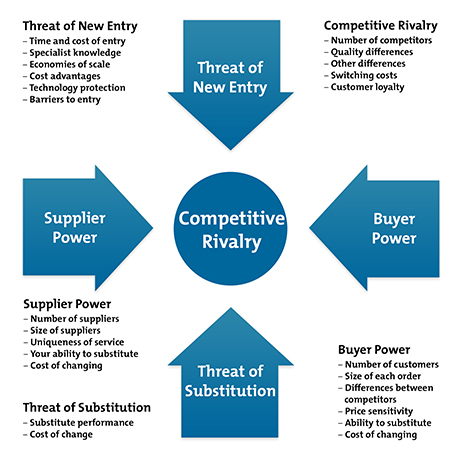This is another one of those classic frameworks. Almost everybody knows it and has seen it in Michael Porter’s book “Competitive Strategy” … I have to admit that I don’t often use it in project work. It has come in handy in the past when I have a discussion with a private equity firm, they want to do a project with one of their portfolio companies, and we have an initial scoping discussion to understand the landscape and the key challenges.
I do a lot of recruiting too, including interviews with MBA candidates. And in those interviews (which generally include case discussions), I hear about the Porter model on a regular basis. Almost too regularly, so my advice to MBA students interviewing for jobs would be to try to use other frameworks if at all possible …
The Porter's Five Forces tool is a simple but powerful tool for understanding where power lies in a business situation. This is useful, because it helps you understand both the strength of your current competitive position, and the strength of a position you're considering moving into.
With a clear understanding of where power lies, you can take fair advantage of a situation of strength, improve a situation of weakness, and avoid taking wrong steps. This makes it an important part of your planning toolkit.
Conventionally, the tool is used to identify whether new products, services or businesses have the potential to be profitable. However it can be very illuminating when used to understand the balance of power in other situations.
Understanding the Tool
Five Forces Analysis assumes that there are five important forces that determine competitive power in a business situation. These are:
- Supplier Power: Here you assess how easy it is for suppliers to drive up prices. This is driven by the number of suppliers of each key input, the uniqueness of their product or service, their strength and control over you, the cost of switching from one to another, and so on. The fewer the supplier choices you have, and the more you need suppliers' help, the more powerful your suppliers are.
- Buyer Power: Here you ask yourself how easy it is for buyers to drive prices down. Again, this is driven by the number of buyers, the importance of each individual buyer to your business, the cost to them of switching from your products and services to those of someone else, and so on. If you deal with few, powerful buyers, then they are often able to dictate terms to you.
- Competitive Rivalry: What is important here is the number and capability of your competitors. If you have many competitors, and they offer equally attractive products and services, then you'll most likely have little power in the situation, because suppliers and buyers will go elsewhere if they don't get a good deal from you. On the other hand, if no-one else can do what you do, then you can often have tremendous strength.
- Threat of Substitution: This is affected by the ability of your customers to find a different way of doing what you do – for example, if you supply a unique software product that automates an important process, people may substitute by doing the process manually or by outsourcing it. If substitution is easy and substitution is viable, then this weakens your power.
- Threat of New Entry: Power is also affected by the ability of people to enter your market. If it costs little in time or money to enter your market and compete effectively, if there are few economies of scale in place, or if you have little protection for your key technologies, then new competitors can quickly enter your market and weaken your position. If you have strong and durable barriers to entry, then you can preserve a favorable position and take fair advantage of it.
These forces can be neatly brought together in a diagram like the one in figure 1 below:

Комментариев нет:
Отправить комментарий